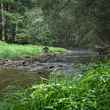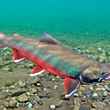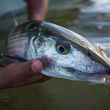The drag was squalling. There’s no better word for it. No staccato clicks at all. No crescendo. Just one long note of protest.
The protest began as gills flared after a nervous cast and one strip. I remember outfitter Ryan Lambert yelling at me to set the hook, then raw power transmitted from leader to line to rod. The reel took the brunt of it with a silky smooth confidence and that shrieking battle cry.
I chose the 9-weight as preparation for wind but was now thankful for its fish-fighting burly backbone. I could see the redfish clearly through tea-colored marsh water. It was a nice fish, a good fish, but it was pulling with torque that was out proportion with what my eyes were telling me. My god, where does that power come from? After three runs, the red sulked within 10 feet of the boat, except for the occasional bulldog head shake that tremored through the rod. “Easy, easy,” said Ryan, somehow knowing my instincts were telling me to horse the fish up as I’ve done with so many largemouth bass over the years. But no matter how stout your rod and reel, that tactic will fail with 12-pound tippet and an 8-pound redfish. And I don’t think I could’ve moved the fish anyway. Even as I dared to push the limits of pressure, the fish wasn’t budging. Finally, the red succumbed to my gentle persuasions and Grant, one of Ryan’s stellar guides hoisted the copper beast aboard.
The lone ebony tail spot drew my eye. Flares of Louisiana sunlight reflected around its edge but many of the sun's rays were captured in the sphere of blackness. It was a solar eclipse in miniature. Or maybe, I thought as my forearm spasmed with exhaustion from battle, it was the dilated pupil of Sauron. Whatever metaphor you prefer, the redfish is a force of nature.
A bold and beautiful apex predator of brackish waters, redfish are properly called red drum. They spawn in rich estuaries along the Atlantic and Gulf coast and leave the marsh at adulthood, sometime around five years of age. But they rarely go far during their potential 40 year lifespan. The redfish doesn’t just live in the Louisiana marsh. The redfish is the Louisiana marsh. Aldo Leopold spoke of the “imponderable essence” that is a creature so tightly bound to its place that the relationship pushes beyond clinical biology and ecology, beyond aesthetics, and into a fuzzy realm that few ponder but all unknowingly realize. He called that essence “the numenon of material things,” and goes on to say that “it stands in distinction to the phenomenon, which is ponderable and predictable.” Leopold used a ruffed grouse as his first example of numenon (spelled noumenon nowadays): “Everybody knows, for example, that the autumn landscape in the north woods is the land, plus a red maple, plus a ruffed grouse. In terms of conventional physics, the grouse represents only a millionth of either the mass or the energy of an acre. Yet subtract the grouse and the whole thing is dead. An enormous amount of some kind of motive power has been lost.” Redfish contain enormous motive power. Subtract the redfish and the whole marsh is dead.
Leopold reserves his designation of “numenon” to wild creatures, but I’ve met a few people whose presence defines a place. Ryan Lambert is one of those people. Ryan is a big dude with a voice, accent, aspirations and personality to match his frame. He started his business as a young man, working nights at a southern Louisiana chemical company and guiding anglers for redfish during the day. I asked when he slept back then. “When I could,” he said. He spoke of running for days on end before exhaustion and sometimes illness would catch up with him, knock him down for a few days, and then bounce back up and ready for another round. Ryan had a vision of making a living on the marshes he’d grown to love since childhood. And today, Cajun Fishing Adventures is the culmination of Ryan’s drive.
Cajun Fishing Adventures facilities sit on a conspicuous and artificially raised section of ground. It’s a common sight in hurricane country where schools, hospitals, office buildings and homes rest on a variety of stilts or pedestals. I arrived at the lodge long after midnight, and after a day that had started nearly 20 hours earlier with Charlie Bush.Thankfully, sight fishing requires overhead sunlight and that meant sleeping in until six, a leisurely breakfast whilst talking redfish with other anglers, and then an entertaining short drive to the water. It was entertaining because Grant was dating Ryan’s daughter, and the entertainment carried on through the day. As someone who’s sat on both sides of this contentious relationship, I could appreciate Ryan’s glee as well as Grant’s gloom.
It was a good thing the crew was entertaining because the fishing was slow. A high tide made for too many hiding places. The marsh was alive with sheepshead, mullet, needlefish, stingrays, and gar, but the redfish proved elusive. Ryan offered no quarter to Grant, but we also discussed the disappearing marsh and just how tragedy could be averted as alligators eyed us suspiciously from the brackish waters
As I explained in the first Vanishing Paradise installment, the levy that stretches along the Mississippi River south from New Orleans to the Gulf of Mexico is the main culprit behind the marsh losing land. You can also add ocean rise through climate change, invasive species destruction, and countless canals slicing through marshland allowing saltwater to inundate previously brackish or even fresh water areas critical to maintaining the delicate systems in place. I say they’re delicate, but hell, they are anything but.
Despite all the crap dumped into Gulf waters, despite the encroaching solvent of salt water that threatens to dissolve the area en masse, despite the stranglehold imposed on natural marsh rebuilding by the levy, and despite our best carbon-heavy efforts to raise ocean levels, the estuaries are still here. They are quickly turning into shadows of their former selves, but still here nonetheless. Though it’s clear that the marshes face an overwhelming array of doomsday players, Ryan thinks that this resiliency is the foundation for the marsh.

“If you let the river and the marsh do what they’ve always done, it’s a very cost-effective way to build land,” said Ryan. That’s the idea behind the Bay Denesse Delta Management Project. Bay Denesse is a terracing project that is premised on a diversion through the Mississippi River levy and into the marsh where the water is slowed. This is the explanation of a terrace project from Erin Brown, sportsmen’s outreach director for the National Wildlife Federation’s Vanishing Paradise: “Terraces are narrow strips of discontinuous land that are created from dredged spoil of nearby channel bottoms. The terraces are placed in open-water bays to ultimately trap sediment flowing from crevasses of a sediment-laden body of water, like the Mississippi River. Terraces also act as a barrier to wave erosion, which allows for the sediment to settle and accrete. As this new rich land is stabilizing, it reduces surrounding pond depth, creating a healthy environment for aquatic vegetation to flourish. In time, this will promote a tranquil nursery ground for fish species, as well as, attract migratory waterfowl as we will see duck potato and wild millet start to thrive in the area.”
Bay Denesse is a joint operation between Ducks Unlimited, the National Wildlife Federation, the Louisiana Wildlife Federation, North American Wetlands Conservation Council, and the Louisiana Coastal Protection and Restoration Authority. It also will depend on individual and corporate support. And this is where Ryan and I have differing opinions. Actually, our difference of opinion goes deeper than this one issue, which is something I discovered about halfway through our day on the marsh when the subject of politics came up.
We needed a bigger boat.
Ryan believes that this project provides an opportunity for some of the very companies that have done the heaviest damage (to be fair, these companies have also provided a multitude of jobs to the area) to the marsh to step up and assist with its protection. And he believes that this project will set a template for future protection and restoration efforts. “Once these business can see the difference they’re making (they’ll be able to see it through satellite imagery) it’ll be like watching their own Chia pet grow,” said Ryan. “And then other companies will want to get involved. If you show them what their money is doing, that it’s going toward something that’s working, they’ll give you more.” I think you can guess my thoughts on this, but it says right here that I’d love to be proven wrong. Fossil fuel industry, sulphur miners, and the various other corporations that have taken and taken from lush Louisiana natural resources — prove me wrong.
Despite our differences, at the end of the day Ryan and I are on the same team. We want to save the marsh and pragmatism is the key word when trying to solve any environmental problems. Whatever works best is what we should do. And somethings got to work. I caught only two redfish during my introductory trip to the Louisiana marsh. Two redfish is nowhere near a lifetime’s needed allotment. I’ve got an itch to get back there and connect with the essence of the marsh, the noumenon of southern Louisiana pulling with a fierce wildness that defines those rich waters.






























Comments
Steven Rockweiler replied on Permalink
Unfortunately, Ryan and I grew up in St. Charles Parish....and now have differing views about the marsh. The biggest marsh owners are the oil and gas industry who own millions of acres. They have slowly...but effectively, closed off huge areas of our coastal region to public access. They are now claiming ownership of natural lakes and bays that have always been State water bottoms. Our state does nothing about this...so they claim more. These well heeled outsiders have stole the very heritage from the the people of this coastal area. The state spent a huge amount of money to restore that marsh down there, and Bert Jones.....and I hear also...Ryan have leased it and posted it...keeping the public out....in an area the public funds paid for. This is upsetting people unbelievably. The state intends to spend between 50 billion and 100 billion of public funds to restore private marshlands....and then turn these restored marshlands back to the owners...who will post them again just like Jones and Lambert. The public has lost their water access rights in this state. We are a growing group, combining with other groups, whose numbers will surprise the oil and gas folks...as well as the state CPRA. I smell ....lawsuits coming ....over spending public funds in this manner, and the CPRA knows this, and are getting mighty nervous now.
Doug Randall replied on Permalink
The people in Louisiana are bought far too cheap. As H. Long said, "get up off your hind feet and bite back" good luck.
Pages